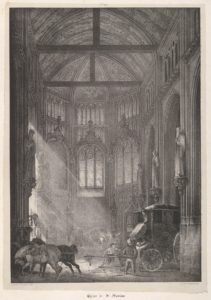The Medium Is the Messagerie
by Allan Doyle
The essay begins:
A lithographic vignette by Théodore Géricault depicting William the Conqueror lying in state was displayed at the Paris Salon of 1824, the first such exhibition to devote a section to lithography. The impact of this morbid scene was undoubtedly heightened by the recent death of its maker who, like the Norman conqueror of England, had died following a riding accident. The print is an outlier within the oeuvre of the artist, who did not participate in the Romantic vogue for historical motifs. Baron Isidore Taylor commissioned the print for the second volume of his Voyages pittoresques et romantiques dans l’ancienne France: Ancienne Normandie (1825). The artist also contributed to the same volume a second full-page print that depicted an interior view of Saint Nicolas, a deconsecrated Rouen church repurposed as a storage facility for a messagerie or carriage service.
 Théodore Géricault, Église de Saint-Nicolas, 1824, Metropolitan Museum, New York
Théodore Géricault, Église de Saint-Nicolas, 1824, Metropolitan Museum, New York
When viewed within the context of French cultural production during the Bourbon Restoration (1815–1830), Géricault’s prints for Taylor’s project reveal themselves to be commentaries on Restoration visual history as much as they are examples of it. Where his Saint Nicolas equates a carriage parked in a deconsecrated church with the manufacture and dissemination of picturesque lithographs of historical motifs, his William the Conqueror figures the national past as an uncannily preserved royal corpse, seemingly frozen in a state of nondecay. On the one hand, the artist provides an allegory of image production in which lithography is presented as an essentially mobile medium capable of transporting the viewer back in time and across geographic space; and, on the other hand, he gives an example of the Romantic and picturesque mode of visual history brought to a state of arrest, suspended between an unrecoverable past and a future placed in perpetual deferral. Continue reading …
In this essay Allan Doyle analyzes the contributions of Théodore Géricault to the second volume of Baron Isidore Taylor, Charles Nodier, and Alphonse de Cailleux’s Voyages pittoresques: Normandie (1820; 1825) within the context of French Restoration historiography. He argues that Géricault’s prints are allegorical commentaries on the production of visual history during this period as much as they are examples of it.
 ALLAN DOYLE is an art historian whose research focuses on the representation of history in nineteenth-century French art and visual culture. He is currently finishing a book on the afterlife of Michelangelo Buonarroti in French Romantic painting.
ALLAN DOYLE is an art historian whose research focuses on the representation of history in nineteenth-century French art and visual culture. He is currently finishing a book on the afterlife of Michelangelo Buonarroti in French Romantic painting.
